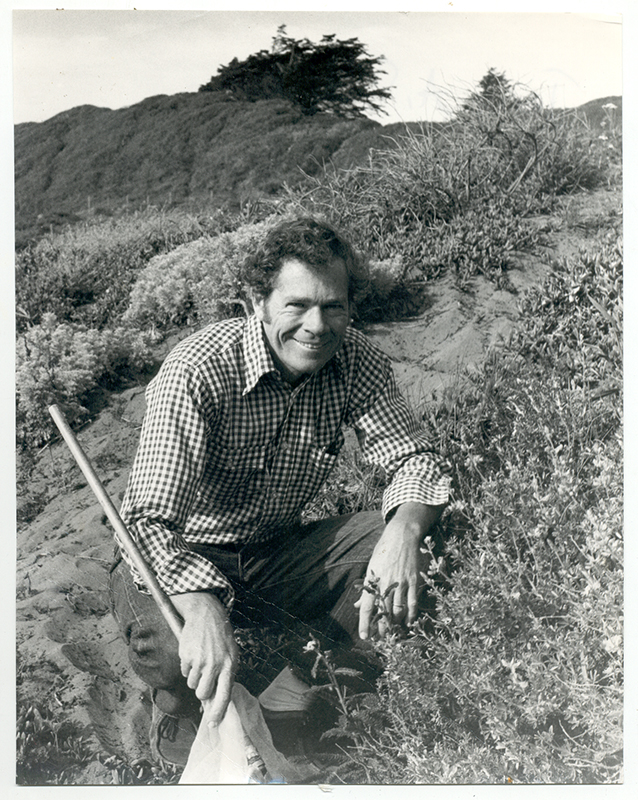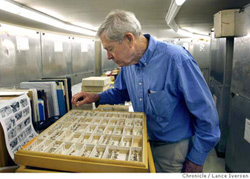 You can make a donation in memory of Jerry Powell to the Essig Museum Fund. Your donation will help us to continue building the collection and making it accessible for research, education, and outreach.
You can make a donation in memory of Jerry Powell to the Essig Museum Fund. Your donation will help us to continue building the collection and making it accessible for research, education, and outreach.
Jerry Alan Powell, (23 May 1933 – 8 July 2023) was born in Glendale CA. In his teen years he was heavily influenced by Charles “Harbie” Harbison, who ran the Junior Naturalist Program at the San Diego Museum of Natural History, and sparked an interest in Jerry for butterflies and moths. Seeing his potential, Harbie recommended Jerry for the Entomology program at UC Berkeley, where he received his BS in 1955 and his PhD in 1961. While climbing through the ranks of Junior Entomologist (1961-62), Assistant Entomologist (1962-67), Associate Entomologist (1967-73), Entomologist (1973-94), Lecturer in Entomology (1964-69), Associate Professor (1969-73), and Professor (1973-94) at UC Berkeley, Jerry also became Curator (1972-2018) and Director (1993-1999) of the Essig Museum of Entomology (1972-1999) and Project Leader for the California Insect Survey (1963-1999). Although he retired as Director in 1999, Jerry remained a professor of the Graduate School until 2012 and maintained an active research program in Lepidoptera life histories and systematics until 2018, advising many students along the way.
 Research Interests
Research Interests
The principal theme of Jerry’s research focused on correlating biological features with traditional morphological evidence in the development of biosystematic relationships of Microlepidoptera (small moths).
Research approach categorized along four lines:
- systematics studies of particular taxa
- comparative biology oriented along hostplant or ecological roles (e.g., yucca moths, fungus feeders, borers of woody composites, leaf miners, sand dune associates)
- a broad spectrum larval rearing program
- faunal inventory
 The major taxa in which Jerry concentrated efforts were New World Tortricinae (Tortricoidea) and Ethmiinae (Gelechioidea). Jerry carried out biosystematic studies of these and a variety of other moths, sometimes in response to requests from other biologists (e.g. our current studies of Choristoneura in cooperation with forest entomologists) or as taxonomic problems became evident during biological and faunal studies.
The major taxa in which Jerry concentrated efforts were New World Tortricinae (Tortricoidea) and Ethmiinae (Gelechioidea). Jerry carried out biosystematic studies of these and a variety of other moths, sometimes in response to requests from other biologists (e.g. our current studies of Choristoneura in cooperation with forest entomologists) or as taxonomic problems became evident during biological and faunal studies.
Jerry’s rearing program was the most extensive in the history of the study of New World Microlepidoptera. For over 50 years he and his students processed more than 15,000 collections of larval or live adult Lepidoptera. Resulting data encompass more than 1,000 species of moths, through rearing either field-collected larvae or those emerging from eggs deposited by females in confinement. This total includes more than 60% of an estimated 1,500 species of Microlepidoptera occurring in California.
Other Research Projects
 Classification of Nearctic and Neotropical Tortricinae. Jerry conducted long term studies of the Nearctic fauna, published a framework for the classification of Neotropical genera, species level treatments of several of the genera, and checklists of the North American and Neotropical faunas. His studies on relationships among the Neotropical genera emphasized the Tribes Archipini, Atteriini, Sparganothidini, and Euliini.
Classification of Nearctic and Neotropical Tortricinae. Jerry conducted long term studies of the Nearctic fauna, published a framework for the classification of Neotropical genera, species level treatments of several of the genera, and checklists of the North American and Neotropical faunas. His studies on relationships among the Neotropical genera emphasized the Tribes Archipini, Atteriini, Sparganothidini, and Euliini.
Faunal inventories. In an era when there is considerable interest in biodiversity and extinctions, it is a paradox that we do not have a complete list of the Lepidoptera species, including an estimate of the undescribed species, for any state, county, or locality in North America. Jerry initiated inventories at several localities in California; the most comprehensive of these are the faunas of Santa Cruz Island, Walnut Creek, and Big Creek, Monterey Co., devoting a large portion of time to the last. Jerry and his students made numerous trips to the site, having sampled over 200 dates, spanning all months, and processed nearly 300 blacklight samples and more than 1,300 larval collections, representing about 340 species (37% of the known fauna of 910+ species).
The ultimate goals of these biodiversity studies were to: a) develop comprehensive local inventories of the species, which can serve as a baseline for comparison of other Nearctic and tropical faunal inventories; b) provide means for estimating species richness in North Temperate Zone lepidopterous faunas by projecting from species accumulation rates and from floral diversity, which often is documented well ahead of that of insects; c) analysis of larval host plant relationships of the Lepidoptera communities.
Professional Society Service
The Lepidopterists’ Society, Editor (Journal of the Lepidopterists’ Society) 1964-69, (Supplements) 1969-71; Member Executive Council, 1973-75; Vice President, 1985-86; President, 1987-88. Pacific Coast Entomological Society, Assistant Editor (Pan-Pacific Entomologist) 1957-62; Chairman Publication Committee and Editor Memoir Series 1965-70, 1973-78; Vice President, 1963, President, 1964. Co-chairman, Panel of Advisory Editors, University of California Publications in Entomology, Review Editor (Bulletin of the California Insect Survey), 1973-1994. Xerces Society, Board of Directors, 1977-80. Board of Editors, The Moths of America North of Mexico, 1979-2012. Society of Systematic Zoology, Executive Council, 1985-87; President-Elect, 1988; President, 1989.
Awards and Fellowships
Principal investigator, N.S.F. grants GB-4014, 6813X, “Comparative biology of Microlepidoptera,” 1965-70; BSR 8411459; “Systematics of Tortricine Moths,” 1985-88; PEET (Partnerships for Exchange of Expertise in Taxonomy), “Training of taxonomists for monographic and database research on Tortricine moths,” 1995-2000. Visiting research associate, Smithsonian Institution, 1970-71. Fellow, California Academy of Sciences, San Francisco, 1971-2018. Principal investigator, U.S.D.A. Forest Service CANUSA/West Research Agreement 59-2061-0-3-014-0, “Taxonomic relationships and pheromone isolation among western spruce budworms populations,” 1978-81. Visiting research associate, Commonwealth Scientific and Industrial Research Organization, Canberra, Australia, 1980-81. The Karl Jordan Medal, The Lepidopterists’ Society, 1982. The Berkeley Citation, University of California, 2000. The John Comstock Award Honoree, Pacific Slope Section, The Lepidopterists’ Society, 2003. Thomas Say Award, Entomological Society of America, Pacific Branch, 2005. Honorary Life Member, The Lepidopterists’ Society, 2010
Selected Publications
 Powell, J. A. 1991. A review of Lithariapteryx (Heliodinidae), with description of an elegant new species from coastal sand dunes in California. J. Lepid. Soc. 45(2):89-104.
Powell, J. A. 1991. A review of Lithariapteryx (Heliodinidae), with description of an elegant new species from coastal sand dunes in California. J. Lepid. Soc. 45(2):89-104.
Brown, J. W. & J. A. Powell. 1991. Systematics of the Chrysoxena Group of genera (Lepidoptera: Tortricidae: Euliini.) U. Calif. Publ. Entomol., Vol. 111:1-129.
Powell, J. A. 1992. Interrelationships of yuccas and yucca moths. Trends in Ecol. & Evol. 7(l):10-15.
Powell, J. A. 1992. Recent colonization of the San Francisco Bay Area, California, by exotic moths (Lepidoptera: Tineoidea, Gelechioidea, Tortricoidea, Pyraloidea). Pan-Pacific Entomol. 68(2):105-121.
Powell, J. A. & D. L. Wagner. 1993. The Microlepidoptera fauna of Santa Cruz Island is less depauperate than that of butterflies and larger moths. In “Third California Islands Symposium, Recent advances in research on the California Islands”, Santa Barbara Nat. Hist. Mus., pp. 189-198.
Powell, J. A. 1994.Biogeography of Lepidoptera on the California Channel Islands. In “The Fourth California Islands Symposium: Update on the status of resources; Sta. Barbara Mus. Nat. Hist., Santa Barbara; pp. 449-464.
Powell, J. A. 1996. Biosystematic studies of conifer-feeding Choristoneura in the western United States (Lepidoptera:Tortricidae). J. A. De Benedictis et al. (1995) U. Calif. Publ. Entomol.
Powell, J. A., et al. 1999. Evolution of larval food preferences in Lepidoptera. Lepidoptera, Moths and Butterflies. N. P. Kristensen. Berlin, Walter de Gruyter. Volume 1: Evolution, Systematics, and Biogeography: 403-422.
Powell, J. A. and P. A. Opler. 2009. Moths of western North America, University of California Press Berkeley. 516 pp.
